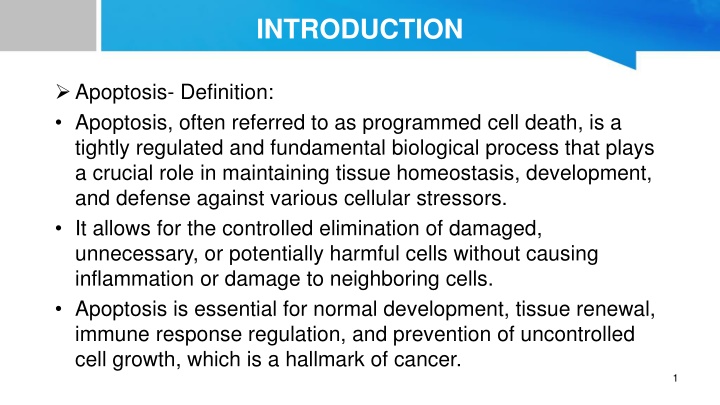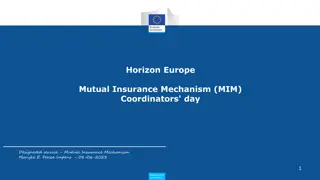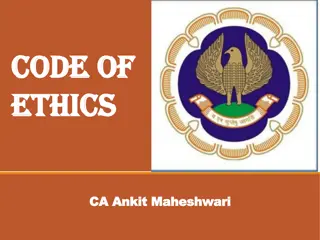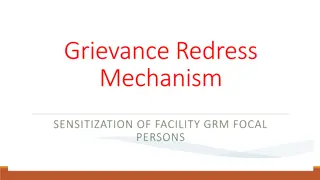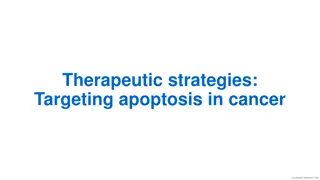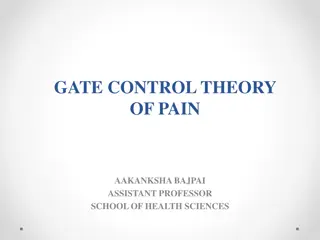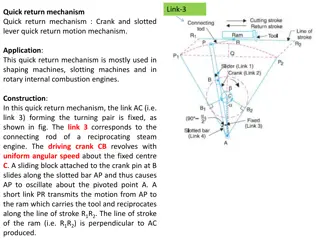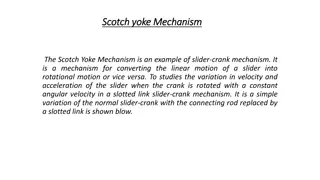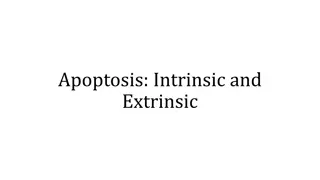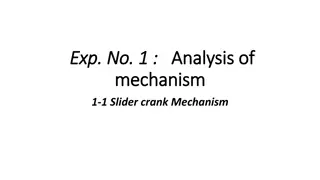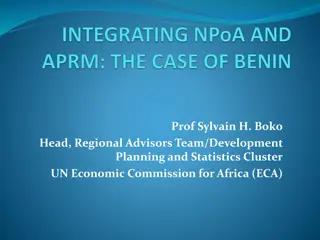Apoptosis Mechanism and Pathways
Apoptosis, or programmed cell death, is a crucial biological process essential for tissue homeostasis and defense mechanisms. Explore the intricacies of apoptosis mechanism, extrinsic and intrinsic pathways, stages of cell death, and major components including caspases and the Bcl-2 family. Delve into ligand-induced cell death and the role of receptors and ligands in apoptosis regulation.
Download Presentation

Please find below an Image/Link to download the presentation.
The content on the website is provided AS IS for your information and personal use only. It may not be sold, licensed, or shared on other websites without obtaining consent from the author.If you encounter any issues during the download, it is possible that the publisher has removed the file from their server.
You are allowed to download the files provided on this website for personal or commercial use, subject to the condition that they are used lawfully. All files are the property of their respective owners.
The content on the website is provided AS IS for your information and personal use only. It may not be sold, licensed, or shared on other websites without obtaining consent from the author.
E N D
Presentation Transcript
INTRODUCTION Apoptosis- Definition: Apoptosis, often referred to as programmed cell death, is a tightly regulated and fundamental biological process that plays a crucial role in maintaining tissue homeostasis, development, and defense against various cellular stressors. It allows for the controlled elimination of damaged, unnecessary, or potentially harmful cells without causing inflammation or damage to neighboring cells. Apoptosis is essential for normal development, tissue renewal, immune response regulation, and prevention of uncontrolled cell growth, which is a hallmark of cancer. 1
APOPTOSIS MECHANISM The process of apoptosis is highly complex and sophisticated, involving an energy- dependent series of molecular events. 4
MAJOR COMPONENTS OF APOPTOSIS Caspases Bcl-2 Family Receptor and ligand Caspase Caspases (Cysteine-Aspartic Proteases or cysteine-dependent aspart ate-directed proteases) are a family of cysteine proteases that play essential roles in apoptosis and necrosis. Made as inactive precursors pro-caspases Activated by other proteins when the right signal is received 8
CASPASE One caspase cleaves the lamin proteins resulting in the irreversible breakdown of the nuclear membrane. 9
LIGAND-INDUCED CELL DEATH Ligand Receptor FasL Fas (CD95) TNF TNF-R TRAIL DR4 (Trail-R) TNF = tissue necrosis factor TRAIL = TNFa-related apoptosis inducing ligand TRAIL-R =Trail-receptor TNF-R = TNFa-receptor DR = death receptor 10
LIGAND-INDUCED CELL DEATH Ligand-induced trimerization FasL Trail TNF Death Domains Death Effectors Induced proximity of Caspase 8 Activation of Caspase 8 11
WHY DO CELL UNDERGO APOPTOSIS? Most cells are provided with an in-built mechanism of apoptosis as a part of the cell cycle. This mechanism allows the body to get rid of unnecessary cells or infected cells. Apoptosis is considered a vital part of various processes including normal cell cycle, proper development and functioning of the immune system, embryonic development, and chemical-induced cell death. Apoptosis occurs in cells that might have been infected with viruses or might even be cancerous. This process usually takes place when the cell detects defects in the DNA and is not able to repair it. 12
WHY DO CELL UNDERGO APOPTOSIS? Apoptosis is also an essential part of the immune system as it clears the pathogen-specific imm une cells once the foreign particle is removed from the body. This also helps to remove the immune cells that might react against the body s cells and cause autoimmune diseases. Another reason for apoptosis is to maintain homeostasis in the body by removing old cells to make space for the new ones. 13
APOPTOSIS PATHWAY Three different pathways work on different mechanisms to achieve apoptosis. Extrinsic or Death receptor pathway The Intrinsic or mitochondrial pathway Perforin/granzyme pathway 14
EXTRINSIC OR DEATH RECEPTOR PATHWAY The extrinsic pathway that initiates apoptosis involves transmembrane receptor-mediated interactions. These interactions take place between ligands and their corresponding death receptors that are all part of the tumor necrosis factor (TNF) family. All members of the TNF receptor family share a common cysteine-rich extracellular domain with about 80 amino acids called the death domain . The death domain plays a vital role in transmitting the death signal from the cell surface to the intracellular signaling pathways. The events or interactions that take place in the extrinsic phase of apoptosis involve two models; FasL/FasR and T NF- /TNFR1 models, both of which include the clustering and binding of receptors and their ligands. 15
EXTRINSIC OR DEATH RECEPTOR PATHWAY Upon ligand binding, cytoplasmic adapter proteins are activated, which causes the receptors to exhibit death domains. The binding of FasL to FasR results in the activation of the adapter protein FADD whereas the binding of TNF li gand (TNF ) to TNF receptor (TNFR1) results in the binding of the adapter protein TRADD with activation of FADD and RIP. These events cause the dimerization of the death effector domain, causing FADD to bind with procaspase-8. As a result of the binding, a death-inducing signaling complex (DISC) is formed, resulting in the auto-catalytic activation of procaspase-8. Once caspase-8 is activated, the terminal phase or execution phase of apoptosis is triggered. 16
THE INTRINSIC OR MITOCHONDRIAL PATHWAY The intrinsic pathway that initiates apoptosis involves a series of non- receptor-mediated processes that produce intracellular signals and act directly on targets within the cell. This pathway involves mitochondrial- initiated events. The factors that initiate the intrinsic pathway produce intracellular signals that might act in either a positive or negative fashion. Negative signals include the absence of certain growth factors, cytokines, and hormones that can lead to failure of inhibition of death programs, thereby triggering apoptosis. In simple words, the withdrawal of factors causes loss of apoptotic suppression and subsequent activation of apoptosis. 17
THE INTRINSIC OR MITOCHONDRIAL PATHWAY The positive factors include, radiation, toxins, hypoxia, hyperthermia, viral infections, free radicals, among others. All of these factors cause changes in the inner mitochondrial membrane that causes the opening of the mitochondrial permeability transition (MPT) pore and release of two main groups of pro-apoptotic proteins from the interm embrane space into the cytosol. The first group consists of cytochrome c that binds and activates Apoptotic protease-activating factor 1(Apaf-1) as well as procaspase-9, forming a protein complex termed, apoptosome. The apoptosome cleaves the procaspase into the active form, caspase 9, which further cleaves and activates procaspase into the effector caspase 3. 18
THE INTRINSIC OR MITOCHONDRIAL PATHWAY The first group also has other proteins like SMACs (second mitochondria- derived activator of caspases) and HtrA2/Omi that promote apoptosis by inhibiting the activity of IAPs (inhibitors of apoptosis proteins). The second group of pro-apoptotic proteins is released from the mitochondria during apoptosis, but this occurs as a part of the terminal phase after the cell has committed to die. These proteins translocate to the nucleus and cause DNA fragmentation and condensation of peripheral nuclear chromatin. 19
PERFORIN/GRANZYME PATHWAY Perforin/granzyme pathway is a novel pathway employed by cytotoxic T lymphocytes that exert their cytotoxic effects on tumor cells and virus- infected cells. This involves secretion of the transmembrane pore-forming molecule, perforin, with a subsequent release of cytoplasmic granules through the pore and towards the target cell. The granules consist of two crucial serine proteases; granzyme A and granzyme B that activate different proteins in the pathway. Granzyme B cleaves proteins at aspartate residues and therefore activates procaspase-10 and can cleave factors lik e ICAD (Inhibitor of Caspase Activated DNAse. 20
PERFORIN/GRANZYME PATHWAY It has also been observed that granzyme B can utilize the mitochondrial pathway for amplification of the death signal by induction of cytochrome c release. But granzyme B can also directly activate caspase-3. In this pathway, there is a direct induction of the execution phase of apoptosis. Granzyme A also has an essential role in cytotoxic T cell-induced apoptosis and activates caspase-independent pathways. As granzyme A reaches the cell, it activates DNA nicking by DNAse enzyme that prevents cancer through the induction of tumor cell apoptosis. Granzyme A protease cleaves the SET complex that inhibits the production of the DNAse enzyme. 21
PERFORIN/GRANZYME PATHWAY The proteins that make up the SET complex together protect chromatin and DNA structure. Thus, the inactivation of the SET complex by granzyme A contributes to apoptosis by blocking the maintenance of DNA and chromatin structure integrity. 22
REGULATION OF APOPTOSIS Several proteins and genes regulate apoptosis. Specific families of proteins are involved in the regulation of apoptosis in various steps. Among all the factors, IAPs and Bcl-2 are two of the most important proteins involved that decide whether the apoptosis is going to complete or inhibit. The extrinsic pathway of apoptosis is inhibited by a protein called c-FLIP which will bind to FADD and caspase-8, rendering them ineffective. Another mechanism of apoptosis regulation in the extrinsic pathway involves a protein called Toso, which blocks Fas-induced apoptosis in T cells by inhibition of caspase-8 activation. In the intrinsic pathway, members of the Bcl-2 family play an important role in the regulation and control of the pathway. 24
REGULATION OF APOPTOSIS The Bcl-2 family of proteins controls mitochondrial membrane permeability, and the proteins ca n be either be pro-apoptotic or anti- apoptotic. The proteins of the Bcl-2 family regulate apoptosis by regulating the release of cytochrome c from the mitochondria via alteration of the mitochondrial membrane permeability. Proteins like Puma and Noxa are members of pro-apoptotic factors that facilitate the activation of apoptosis by preventing the action of anti- apoptotic factors. A group of proteins released from the mitochondria, Smac, promote apoptosis by inhibiting the action of IAPs in the mitochondrial pathway. 25
